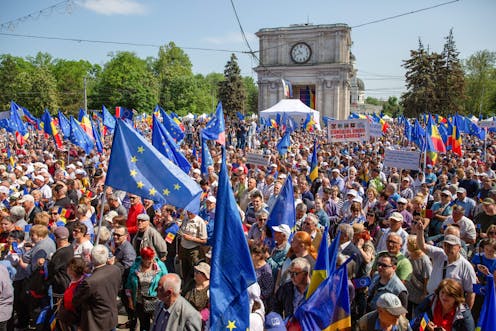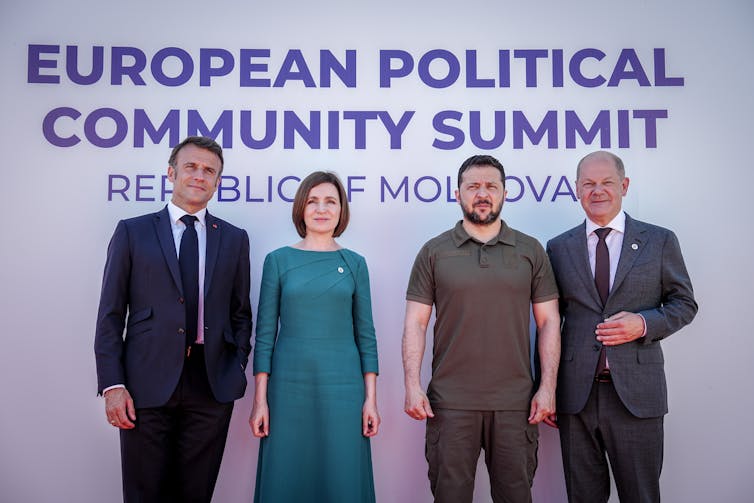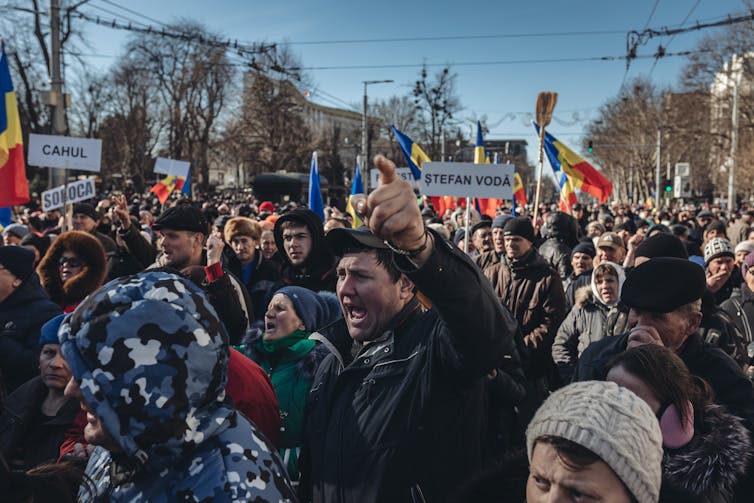
Moldova, one of Europe’s poorest countries, straddles Ukraine to its east and European Union countries to its west – placing it in an arguably vulnerable position in the ongoing war between Ukraine and Russia.
But Moldova, a former Soviet republic, is increasingly signaling that it is aligning itself with the European Union.
Mimi Castle, a wine estate southeast of the Moldovan capital, Chisinau, was the site of a June 1, 2023, political meeting of European leaders focused on security and stability in Europe. Ukrainian President Volodymyr Zelenskyy, who pressed for more Western aid in the fight against Russia, was among the leaders who attended.
Moldova’s Western-leaning government has accused Russia of trying to block its entry into the European Union. But a top EU leader said recently that the organization would welcome Moldova with “open arms and open hearts”.
“Moldova does not want to be blackmailed by the Kremlin,” Moldovan President Maia Sandu said during a pro-EU political rally in Chisinau on May 22.
“We don’t want to be on the outskirts of Europe anymore,” continued Sandu, who said her goal is that Moldova joins the EU by 2030.
One major complicating factor for Moldova, though, is that an eastern section of its territory, Transnistria, has been occupied by Russian troops since 1992.
As a researcher on Eastern Europe, I think it is important to understand the reasons Moldova might have a hard time breaking away from Russia’s orbit.

Moldova’s population is split
Moldova first applied to join the EU – a process that takes nine years, on average – in March 2022, shortly after Russia launched a full invasion of Ukraine.
But the country’s population of roughly 3.4 million people is split on this move, according to the Moldovan polling company Magenta Consulting.
Approximately 48% of the population said in March 2023 that Moldova should join the European Union, while 34% expressed their support for maintaining ties with Russia.
Despite the citizens’ split sentiment, Moldova is already moving away from Russia. In May 2022, the government announced its desire to leave the Russian-led Commonwealth of Independent States, a regional political and economic group set up after the Soviet Union dissolved in 1991.
However, Russia still has political influence in Moldova.
A pro-Russian politician, for example, won an election for governor in Gagauzia, an autonomous region in southern Moldova, in May 2022.
Sandu has also accused Russia of trying to overthrow Moldova’s government and replace it with a puppet regime picked by the Kremlin.
Resistance to corruption reform
There are different conditions that countries need to meet before they formally start negotiations with EU countries to become part of the organization.
The European Commission has spelled out nine reforms it wants Moldova to make – six of them are focused on fighting corruption in the justice sector. Corruption in Moldova is widespread.
The Moldovan government is now undertaking a comprehensive reform of its justice system, in advance of entering formal negotiations to join the EU by the end of 2023.
However, some Moldovan judges are resisting efforts to make anti-corruption changes, which would include a pre-vetting system for potential judges. As a result, there have been widespread resignations of judges, paralyzing the Supreme Court of Justice due to too few members remaining in office.

Lack of border control
Another complicating factor in Moldova’s bid for EU membership is Transnistria, a pro-Russian breakaway region that separated from Moldova with the help of the Russian army after the fall of the Soviet Union.
The Transnistrian government has de facto independence, but other countries and the United Nations simply recognize it as as part of Moldova.
People living in Transnistria are largely Russian speakers, and the government is run by pro-Russian separatists.
Russia also provides Transnistria with free natural gas and has supported older people in the region with pension money.
The presence of Russian troops in Transnistria prevents Moldova from fully controlling its own borders. If activated, combat-ready Russian troops in Transnistria could quickly destabilize the region.
One condition for EU membership is border and territorial control. Without this, Moldova cannot join the EU.
Cost-of-living crisis
Moldova’s heavy reliance on food and energy imports from Ukraine and Russia made it vulnerable to conflict-related disruptions to food and energy supplies from Ukraine and Russia due to the war in Ukraine.
Moldova’s inflation rate reached an all-time high of 34.6% in October 2022. The country’s inflation rate has since eased, but still stands at 18%. High living costs have sparked protests over the past several months, with people concerned about energy prices, but also about the ability to afford other necessities like milk.
Unstable energy sources is another concern for Moldova.
Ukraine cut its electricity exports to Moldova after Russian missile strikes targeted the country’s energy infrastructure in 2022. And Russia cut the daily gas it gave to Moldova by half in October 2022, resulting in electricity blackouts and concern about the country running out of power in the winter.
In an attempt to escape Moscow’s orbit, Moldova started importing natural gas from other international sources, mainly from Romania, in December 2022.
The influx of Ukrainian refugees to Moldova has resulted in additional financial costs. Over 800,000 Ukrainian refugees crossed the country’s eastern border – and 100,000 Ukrainians are now living in Moldova.
While the challenges faced by Moldova are significant, there is also reason to think it might join the EU. In April 2023, the European Union’s parliament reaffirmed its commitment to Moldova’s EU membership. But some of Moldova’s problems, like lack of full territorial control and deep-rooted corruption, are unlikely to fade quickly.
Tatsiana Kulakevich does not work for, consult, own shares in or receive funding from any company or organization that would benefit from this article, and has disclosed no relevant affiliations beyond their academic appointment.
This article was originally published on The Conversation. Read the original article.







